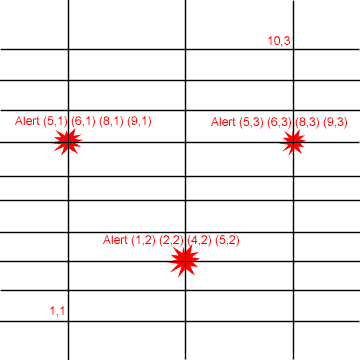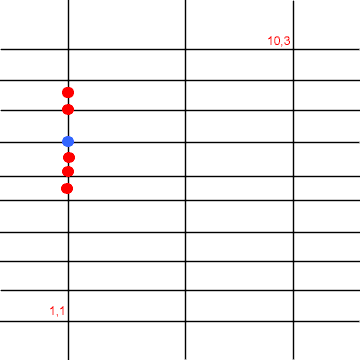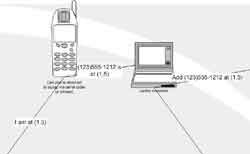Prepared by Staff for Why War?
An Introduction to Swarming and the Future of Protesting
Aug. 1 — There is a significance to the simultaneous emergence of the idea of the swarm. It is a concept birthed from a metaphor. In each discipline a certain representation of how information is dispersed has taken hold: visually represented as the rhizome or the network. Biology, for example, has discovered that certain species such as ants have evolved a biological information sharing method that gives them, as a mass, an intelligence. Power flows throughout their body-politic. Based upon such advances, one could argue that the understanding, and re-imagining, of networks is the most important concept driving innovation today.

This hypothesis is strengthened by the fact that our own understanding of networks is not only broadening as we look at “social networks” but even changing as we try to discover the best way to share that pirated mp3. The information flows that are file-sharing have gone from centralization under Napster to de-centralization under Gnutella to partial swarming under Edonkey to total swarming under BitTorrent. Each step requires a new algorithm, a new shared metaphor. It takes years to create them, and some are not even done: Freenet.
The question of how to effectively, and most powerfully, organize an information sharing network has seeped into activism — popularized by MoveOn.org’s custom-coded scripts that allow tens of thousands to synchronize their action from diverse locations for traditional grassroots organizing tactics such as calling their congressperson. But ultimately even MoveOn is powered by a tool we all have: e-mail. After all, even MoveOn began as a mailing list. The movement’s continued attempts to create online communities for specific end-goals has forced new ways of organizing ourselves. Originally the Internet, like its creators, was lonely and amazed with its own ability to simply create another person to chat. America Online socially networked the high-schools, IRC the world, and e-mail the intellectual.
We are just now beginning to see the Internet’s first attempt to challenge the world’s superpowers. By challenging Bush — which in this age necessitates an Internet connection — we are putting an emphasis on social-networks that activate and initiate actions in the material, real world. The “smart mob” that we strive for is evolving before we can imagine or articulate it. We know there is power here ... somewhere.
The fundamental question still is, however, how exactly should we manifest ourselves physically. And for now it seems we are stuck with one answer: visibility. Naively thinking that the media (their media) is our sword we forget that what makes us operate now is not the television but the media materialized in our computer by the Internet. The recent decision of the Senate to block the Total Information Awareness program is at least the second time that a Bush Regime policy has been undone purely because the Internet was able to spread information more effectively than the mass media could silence it. The first example was the outrage that was directed against the TIPS program. It wasn’t because of CNN that we even heard about this program, but because of a single journalist for a single newspaper in Australia who broke the story: “US Planning To Recruit One In 24 Americans As Citizen Spies.” The Internet carried that story to every member of the movement. And I believe the result will be the same for the newest high powered meme — the news of the voter scam being perpetrated by Diebold, an odd company that makes ATM machines and paper(trail)less election computer systems.
For too long we have believed that the traditional protest was our most powerful tool.
I propose there are at least two specific aspects of the traditional protest that we intuitively know have power:
- Our Ability to Disrupt the Functioning of Symbols of the State
- Let us not forget that the synchronized movement of these actors we disrupt are the result of another by product of a network of shared information.
- Our Ability to Force Our Meme, Our Thought-Virus, Into Other People’s Minds, Thereby Increasing Our Membership
- In this way we used the media, but now we know we can create the (indy)media.
Given the emergence of all that the beginning of this essay dealt with, it is clear we can safely, and more efficiently, move all the activities related to the second point under the guidance of the Internet. We don’t need protests to be covered by the media in order to articulate our message because we now function via a network independent of mass media. We are speaking into peoples homes every second of every day, not just at protests.
But the first point is more difficult to separate and replace with the Internet. Instead we should seek to maximize that aspect by focusing all of our “organized” protest energy on fine-tuning the nonviolent-citywide shutdown. First we were centralized — International ANSWER manifested us by widely claiming a day. But it was Indymedia that de-centralized us by bringing us down locally — more accurately, nodally. Because of Indymedia’s structure any of us are able to begin our own.
How we swarm, however, is still the mystery that we are stumbling towards.
Swarming is a concept that owes its existence not just to Howard Rheingold’s “smart mob” but also to RAND’s John Arquilla and David Ronfeldt. These RAND theorists have made the curious discovery that swarming tactics, which they describe as “a seemingly amorphous, but deliberately structured, coordinated, and strategic way to strike from all directions, by means of a sustainable pulsing of force,” have often defeated larger, more advanced militaries (“Swarming and the Future of Conflict”, pg 45). This is true historically: many different armies have organized themselves into a swarm. Because swarming necessitates a shared information network, it is a developing military theory that evokes not only classic historical studies such as “Swarming on the Battlefield: Past, Present, and Future” but also the post-structuralist theory of “The Emergence of the Noopolitick”. Notice that the inspiration behind their work on the noosphere comes not from generals, but philosophers: Teilhard de Chardin, Foucault and Derrida.
It is Gene Sharp that has given the movement an insight necessary for us to have even come to this discussion of swarming by way of the military. His philosophy of nonviolence is a philosophy of strategy and tactics. His conclusion is two part: first, that there are dozens of sub-categories of nonviolence, and second that nonviolence can be as tactically powerful as violence. Absolute pacifism, the type we are taught by the mass-media, the type of pacifism that asks the believer to become purely inactive, is not the pacifism of the true nonviolent revolutionaries. Gandhi and Martin Luther King, Jr. both understood that nonviolence is a powerful technique, but still a sibling of violence. They adopted nonviolence not out of a desire to fail to challenge the violence of the state while maintaining moral superiority, but in order to win.
It’s time to think about winning.
Have you shaken your doubt and reluctance toward action yet? I’ve seen the circle turn enough times to realize that there is one undeniable truth: the most powerful individuals are now too powerful. I was afraid to believe myself on Oct. 9, 2002, when the Guardian told me “White House ‘Exaggerating Iraqi Threat’” and even though it was an American newspaper that now insisted I was being duped, the San Francisco Chronicle’s headline on Oct. 12, 2002, “Bush’s Evidence of Threat Disputed,” didn’t wake me. But how can I look back and see “Prague Clears Iraq of Last Connection to al Qaeda” (New York Times, Oct. 21, 2002), “Perle Says US to Attack Iraq Despite Inspections” (Mirror, Nov. 11, 2002), “CIA, FBI Staffers See No Link Between Iraq, al Qaeda” (New York Times, Feb. 2, 2003), “Bush Message is Inevitable War” (Washington Post, Feb. 25, 2003), and finally “Bush Orders America’s First Pre-Emptive War” (Chicago Tribune, Mar. 20, 2003), and not realize I do believe my fears. I am ready to act, to win.
The path forward is far from clear. Perhaps paradoxically, I’m not completely convinced that we can even entirely predict how the movement will organize itself. But there is indication that it will choose, or be forced to choose, a protest model based upon the simultaneous materialization of flash-protests specifically designed to shut down the economic flows of a city without violence, without riots, and without giving the state any excuse for their obligatory retaliatory violence.
I imagine waking up one morning and finding an e-mail asking me to be at this corner at that time. I faithfully follow the directions only to find that a couple dozen others have materialized as well. Whispers through the crowd of the anonymous tell me that such groups have materialized on street corners across the city. At noon, with a smile, we step into the street and stop.
Adding Intelligence to the Mob
Aug. 6 — Above I offered a brief sketch of the importance and origins of the emergence of the new concept of swarming. Now I’d like to present some specific ideas on how the movement can adapt what has been up until now a largely military doctrine. Perhaps ironically, it has been the movement that the originators of the military doctrine of swarming have looked toward for inspiration. From the actions at the 1999 Seattle protest, which prompted the now famous essay “Netwar in the Emerald City,” to the zapatista movement, the theorists of RAND have been seeing something significant. That the movement, however, may act unconsciously as a swarm when the conditions are right will not win the larger war. Instead, the practice of swarming must come to be a practiced, and refined doctrine — a strategy. Fortunately, if history is any guide the movement may be the place that ultimately a powerful intentional strategy of swarming will arise. It was social movements, as John Arquilla and David Ronfeldt point out in Swarming and the Future of Conflict, that were the first to develop theories of swarming:
The most clearly developed theoretical work on [swarming] can be found at the level of social conflict. In anarchist thought, for example, the “general strike” theory of Mikhail Bakunin focused on the notion of pulsing the power of workers in simultaneous strikes aimed at bringing down the state. As E.H. Carr put it, Bakunin used his general strike theory as a means of overwhelming the state, a “conception of revolution through the people by destroying the power of the State” (1950, p. 101). His approach is strikingly different from classical revolutionary thought, which instead keys on ways to seize state power and use it in ways that are often ultimately beneficial to the state itself. [pg 41]
Swarming, for the purposes of protesting, can be thought of as the technique of quickly massing a large number of individuals from all directions onto a single position in order to attain a specific goal. There are roughly four different phases in a sucessful swarm: locate the target, converge, attack, disperse. For these four phases to work correctly they must be synchronized between a diversity of seemingly disconnected individuals. Therefore, there must be a layer of instantaneous communication between these individuals. This level of communication is the most difficult aspect of swarming — and a prerequsite that has made swarming up until now much harder to accomplish. There are now several wireless communication options available, the most prevalent being the cell phone. The other difficulty is how to first mass the necessary amount of people in order to swarm them to a specific location. Before dealing with this this type of situation, let’s take a specific example of how swarming could have been successfully used in a situation where thousands, in this case hundreds of thousands, were already present: the Febuary 15, 2003, protest in New York City.
The police faced a difficult situation at F15: they knew that tens, possibly hundreds of thousands of people were going to attend the march. They also knew that the organizers wanted to have a rally point with big-name speakers and that most people would want to reach that location. So their strategy was simple: they made it extremely difficult to travel across the avenues toward the rally point, but allowed people to walk north or south. Their goal was to infinitely multiply the amount of walking required to get from First Avenue to Third Avenue. An easy way to visualize this would be to create a grid with 10 blocks vertically and 3 blocks horizontally (figure 1). The vertical lines represent streets and the horizontal lines represent avenues. If you wanted to get from (1,1) to (10,3) you had to first walk up to (10,1) and then (they told us) you were allowed to cross over to (10,2). From there you had to walk to (1,2) and then cross over to (1,3); then you’d be able to walk up to (10,3). The avenues themselves were barricaded with police preventing people from crossing them.

This strategy worked very well against the majority of people because they would never even think of breaking down the barricades (which, as we discovered, was extremely easy). The strategy failed when a critical mass of individuals massed at any particular coordinate. The mass would then begin to push on the barricade, and soon they’d break through.
As is clear from this analysis, there were various flash points where a critical mass had massed and either civil disobedience or police violence began. The problem from the perspective of the protester was that although there were 500,000 people at the protest they were spread across dozens of blocks and were only aware of the situation in their immediate vicinity. This resulted in the police having the only bird’s eye view of the protest and the ability to violently repress the minority who happened to be there. A solution to this problem would have been a communication network that would have allowed an individual at one of the flash points to alert hundreds of individuals throughout the greater mass who could then alert their peers to the situation.
Using Your Cell Phone to Coordinate Via Text Messaging (SMS)
Upoc.com: Two-way all-channel communication
Upoc.com allows people to join cell phone groups that receive text messages. These groups are exactly the same as mailing lists, except instead of receiving an e-mail you receive a text message on your cell phone. The easiest configuration would be to encourage people to sign up for the Upoc.com group prior to the protest. The group could be set to accept messages from any member so that each person would have the ability to alert the greater cell phone group of the events in their location. The members who receive the bulletin could then shout out the information to the individuals nearest them and head for the flash point. This would immediately overwhelm any police at the flash point and would be virtually impossible to stop. After the protest people could simply unsubscribe from the group.
However, there are a few major weaknesses in the Upoc system. First, given a sophisticated police force they might be able to either shut down the Upoc group immediately prior to the protest or use the cell phone numbers to track down and prosecute individual users. Although I’m not a lawyer, I doubt that it is illegal to merely receive text messages which indicate the situation at various corners throughout a protest. Even if the police did go down this route, however, the emergence of pre-paid cell phone service now allows anonymous cell phone use. To do this one needs only buy an unlocked GSM cell phone from eBay — usually for around $100. They can then walk into any cell phone service provider offering pre-paid service and sign up for an anonymous cell phone account for about $50. This has been successfully tested in San Francisco with Cingular Wireless. After the protest one could just remove the sim card and sign up for a different account. This would result in untraceable, anonymous wireless service for the day of the protest.
The primary reason that we should move beyond Upoc is that it’s a commercial system and that everyone receives the same message. But if you are at (3,2), information about what is occuring at (10,1) is no use to you. Instead, it is actually detrimental because it would encourage mindless chasing of the latest flash point. The police would need only receive the SMS message then radio their counterparts to prevent anyone from moving toward the location. For this reason we suggest that people discard the Upoc system along with systems that rely on relaying the same information to every user. As an alternative we offer a far more robust, localized system.
Localized Coordination and Swarming Using Consumer Electronics

During the course of our research about alternatives to Upoc and similar systems we discovered that it was technologically feasible and cost-effective to run our own SMS system. Furthermore, a custom system would allow the user to interact with a specialized database, which opens up some amazing possibilities. Let’s turn again to our hypothetical situation loosely based off of the F15 protest in New York, except let’s complicate the system slightly by imagining that there are three different flash points (figure 2).
As you can see from this diagram, the situation is that there are flash points developing simultaneously at (7,1), (3,2) and (7,3). What we want to do is alert people within two blocks north or south of these flash points that they should swarm the location. Previously there was really no feasible way to selectively notify different people within a mass that there were events within distance of them. But using a home-built system this is now possible (figure 3).
The system we are proposing is given basic shape in the figure above. The basic components are as follows:
- A protester with a cell phone and a map of the coordinates so that they can translate their location to a predetermined coordinate.
- A GSM cell phone hooked up to a computer via a serial cable or an infrared link. The computer needs to be running SMS Server Tools, a free and open-source program.
- The computer needs to have access to a simple database that keeps track of people’s cell phone numbers and their location.
- We’ve listed above that this system would use a bulk SMS server, such as Clickatell; we will discuss this and other options below, but for now just think of the bulk SMS server as any method of delivering a SMS back to the protester. At the bare minimum, the same cell phone that is receiving the SMS could be used to send them.
The protester would interact with the server by sending an SMS message prefixed by various commands.
At minimum the system would be able to understand and act upon three different types of commands:
- ON Location: Tells the server that the individual is joining the swarm and is at this location.
- OFF Location: Tells the server that the individual is leaving the swarm (this is useful for implementing a concept called clustering that we’ll explore later).
- FP Location, Message: Tells the server that there is a flash point at the given location and to forward the following message to others within distance.
A fourth option could be to assign each message a unique ID number so that people could confirm or deny the message. This would allow people to remove spammers and disinformation from the swarm.

This will probably become clearer if we go through a simple example. In the diagram below (figure 4) we have six different affinity groups, each represented by a dot. In this example we will focus on the blue dot.
- The blue dot decides that they are tired of walking north, so they notify the system of their location by sending an SMS message which says “ON (7,1)”.
- The system takes their cell phone number and location and inputs it into the database
- As the blue dot is standing there they see a different affinity group take the street. They quickly message the system with the command “FP (7,1), Group taking street. Few police.”
- The system takes their message and relays it to the five other connected affinity groups represented by red dots.
- Once these groups receive the message they shout out the information to the protesters around them and then head toward the swarm location. Once the police presence or risk of arrest becomes too high, the affinity groups begin to disperse to a new location. Once there they notify the system of their location and the process repeats.
Aug. 8 —There are several major difficulties inherent in implementing a swarming strategy based upon SMS technology. The main one being that SMS is not real-time: it can take seconds, minutes, or hours to deliver a message. We're exploring the possibility of decreasing this delay, but it's important to remember that SMS was not built to be a instantaneous delivery method. Another limitation is that sending messages is, usually, not free. One way of making the delivery free is to have the messages sent directly to the carrier through email. This method was used by NYC indymedia for their M27 SMS network.
What we like about SMS is that all cell phones are capable of receiving it and content can be Pushed, in other words it can be sent to the user. This makes it extremely user-friendly. These are issues that any future swarming system based off of cell phone technology are going to have to reconcile. With those problems in mind, let's move forward and explore another potential option: WAP.
Restating Our Objective: Looking Again At Police Tactics
This article has prompted a lot of excellent discussion, and I've received some very thought provoking emails about various aspects of it. Two in particular that I suggest are these thoughts on swarming and protesting and this very thoughtful critique of my proposal. Both of these refer to an earlier email I had sent to the flashmob list. My main objective in writing this article was to interject the meme of swarming protests into the flashmob community in the hopes that it would fire people's imaginations.
As many people have pointed out there are some inherent differences between the requirements for a successful flashmobbing system and a swarming protest. Contrary to popular belief, however, I do not think that the need to deeply consider future police attempts at disabling flashmobs, even apolitical ones, is something that either group should ignore. I also urge apolitical flashmobs not to sacrifice the original spirit by attempting to negoitiate with police when, and where, a mob can occur. The ploy of having to get a "permit" is a trap that protesters long ago fell prey to, and now suffer from. The main difference from the perspective of a mob organizer is that because I'm placing the focus on conducting the swarm at pre-established protests I'm not particularly concerned with the question of how to first materialize the necessary participants. This is a strategic choice on my part - I trust that flashmobbing will inevitably teach the movement the techniques necessarily to materialize F15 numbers with days, not months, of organizing. But for now, that's a side concern.
That being said, let's go back to our hypothetical protest situation that we presented above. Instead of presenting a new system I will instead try to offer a basic outline of what this new system should attempt to accomplish.
First let's look more carefully at police tactics used for crowd control. As we stated, the first tactic was to create an organized pattern that protesters were forced to move through. This was done by limiting protesters to the sidewalks, barricading sidestreets, then directing people to all walk in the same direction. Essentially, the police in NYC during F15 used the fact that the protestors wanted to have a single 'rally point' by creating a huge, slow moving march. This added a level of predictability to the movement of the crowd - it was like herding cows or sheep. In fact, the external control exerted on the crowd resulted in very sheep-like behavior.
The second police tactic that is now common is to not engage in mass arrests. Popular opposition to the Bush regime is strong enough that if mass arrests were policy every protest would result in the complete shutdown of city jails. Instead police across the country use a very different tactic: selective, brutal arrests in order to scare and pacify crowds. In this way, the police both pick off lone protestors and detain leaders.
Clearly the system we want to develop is something that creates several different, moveable 'rally points' that the entire protest can be infinitely aware of and move towards. These points can be symbolic, like a particular building, or absurd, like a random corner. The goal is to create seemingly spontaneous, nearly unpredictable crowd movements. This will make the game of crowd control excessively difficult, to the point where the police would begin to require more police officers than they currently have available.
As we can see, this system needs an informal information network that will provide individuals within the mass to get a cityscape view of the protest so that they are aware of the various rally points around them. Interestingly, if we approach this system as if it were a game we will probably be far more successful in creating it.
A Different Approach: Radio "Pheromones"
Nov. 4 —Jason Rohrer wrote to me with an idea which expands the Swarming concept to another level. If you're interested in building such a system, please .
Jason writes:
Seems like you could develop a small, cheap special-purpose device to implement your "local swarm-to-flashpoint" scheme.
Think about the way hornets work (or at least the way urban legend says they work---I've never been swarmed by hornets):
- You step on one hornet
- The smashed hornet releases some sort of pheromone into the air
- Nearby hornets sense the "help" pheromone and head towards the source
- You get swarmed by angry hornets
With this in mind, we can think about protest flashpoints.
Since there could be multiple flashpoints in the same field, you don't want *everyone* in the field heading towards the same flashpoint. You want to focus on the people who are already close to a given flashpoint.
In your article, you describe a digital system that uses cell phones and databases to track manually-entered grid locations of protest participants. This is all very complicated, but that's because you're trying to use off-the-shelf digital hardware to build a system that is inherently analog (tracking realtime positions in real-world space).
Let radio waves be your pheromones. They decay over distance just like chemical pheromones.
Each protester, or some fraction of the protesters, can carry a little black box on their keychain with a red "help" button on it. If a protester is present at a flashpoint, s/he can hit the help button, which would send out a radio signal. Nearby protesters' black boxes would respond to this signal by vibrating---stronger vibrations mean you are closer to the source of the help request. Protesters who receive the signal can head in the direction of the stronger vibrations (or follow others nearby who suddenly shout and head in a particular direction). To call for more help and send the request even farther away, responding protesters can hit their own help buttons to reach those that the first help request could not reach.
You could even have several buttons on each black box for different levels of help requests. High level requests would automatically be forwarded by neighboring help boxes. For example, if my box receives a level-4 signal, I feel a vibration, and my box then sends out a level-3 signal to my neighbors. A box getting a level-3 signal vibrates and sends out a level-2, etc. Finally, a box that receives a level-1 signal simply vibrates. Thus, you can specify how many "hops" you want your help request to travel by pushing an appropriate button.
Okay... sounds nice, but far fetched? After prototyping, I'm sure these things could be manufactured for less then $10, maybe even with parts available at any Radio Shack. A grassroots effort could build a lot of these things quickly and get them out there for sale at-cost, and you could even post simple solder-your-own plans on the web.
As far as prototyping goes, remote car door openers are quite similar to what we would need, so we would have a good starting point.



